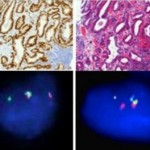Editorial: New possibilities for urinary molecular diagnostics
Fusion of androgen-driven serine protease transmembrane protease (TMPRSS) and oncogenic erythroblast transformation-specific-related gene (ERG) genes is a specific alteration in human prostate cancer and many studies have been performed in order to analyse its role as a biomarker or, even more interestingly, as a tumour promoter [1]. Recently, Nguyen et al. [1] demonstrated that ERG activates the Yes-associated protein 1 (YAP1) transcriptional programme thus inducing prostate carcinogenesis. YAP is a transcriptional coactivator involved in regulation of many biological processes. Thus, there is increasing evidence showing that ERG is causally involved in prostate cancer development. Since the original publication by Tomlins et al. [2], in which the gene fusion was discovered, researchers have addressed numerous scientific questions in order to reveal importance of the TMPRSS:ERG fusion in prostate cancer. This is particularly important because several other proteins have been proposed as prostate tumour markers; however, many of them cannot be used in clinical practice. The reasons for that are related to differences in sampling of tissues and methodologies. Thus, biomarker research will in future probably be restructured on the basis of standardisation of experimental procedures. Biomarker research work related to the TMPRSS:ERG fusion appears to be more advanced. In addition to tissue diagnostics, studies on detection of ERG may be performed in urine as evidenced in the paper by Pal et al. [3]. Moreover, the authors for the first time show that exfoliated urinary cells can be used to identify patients with prostate cancer by detection of positive ERG samples. The authors used nested PCR and urinary immunocytochemistry and fluorescence in situ hybridisation in this study. As the TMPRSS:ERG fusion is detectable in ≈50% of prostate cancer specimens, the data presented in the study published in this issue of BJUI are of considerable interest.
Combining the use of TMPRSS:ERG detection and other markers in urine should further improve diagnostics of prostate cancer. Another tumour marker, prostate cancer antigen 3 (PCA3), is frequently used in prostate cancer diagnostics. In urine, TMPRSS:ERG urinary transcript detection is superior to PSA and PCA3 for identifying patients with cancer [4]. The results support data recently published according to which the determination of urine TMPRSS2:ERG together with PCA3 may be used for a more individualised prostate cancer risk assessment [5].
As the authors state in the paper [3], differences between results of some marker studies on TMPRSS:ERG detection may be a consequence of the appearance of less common isoforms, which are not detectable by all assays.
In summary, Pal et al. [3] show for the first time that patients with prostate cancer could be identified by immunocytochemistry on the basis of detection of ERG in exfoliated urine cells. In addition, the authors [3] also show that the appearance of ERG in exfoliated urine cells is associated with a bad prognosis. Indirectly, the present paper [3], supports the concept that the presence of TMPRSS:ERG regulates various cellular events leading to increased migration and proliferation of prostate cancer cells [6]. It is expected that further improvements in urinary molecular diagnostics based on the presence of TMPRSS:ERG will be achieved in the near future. However, clinicians should also be aware that, despite its high specificity, there are limitations of methodology used in this paper, in particular a large proportion of tumours may remain undetected and not all cancers exfoliate into the urine.



